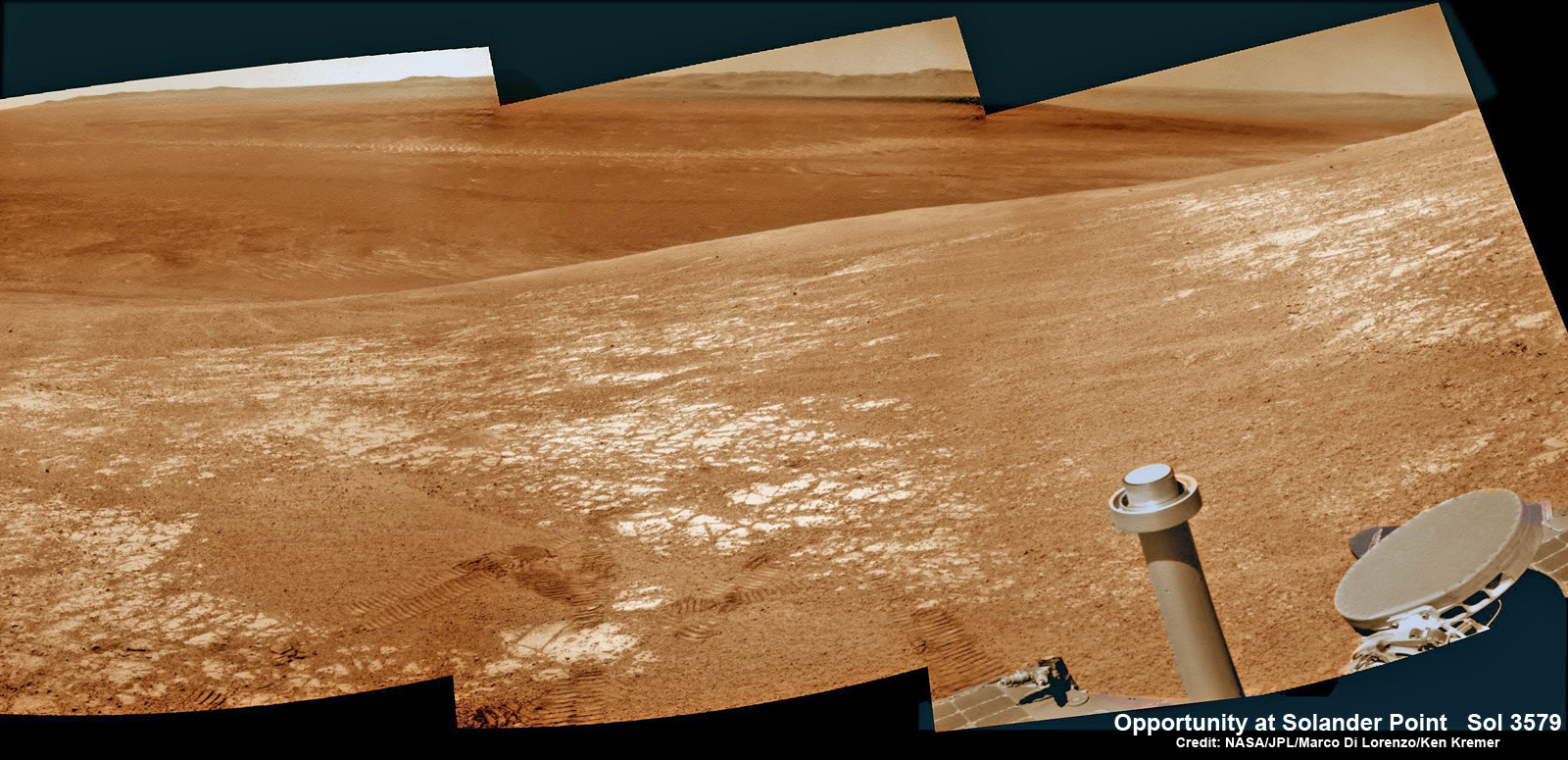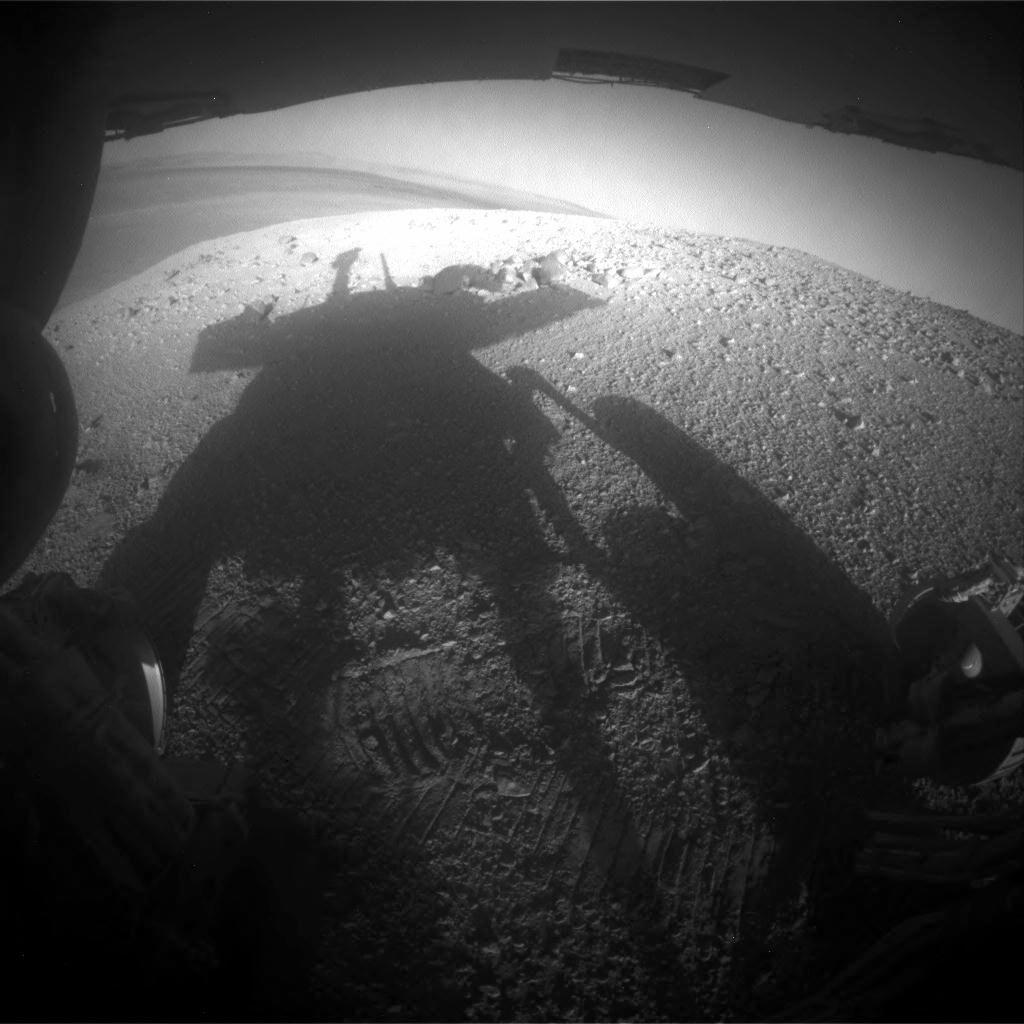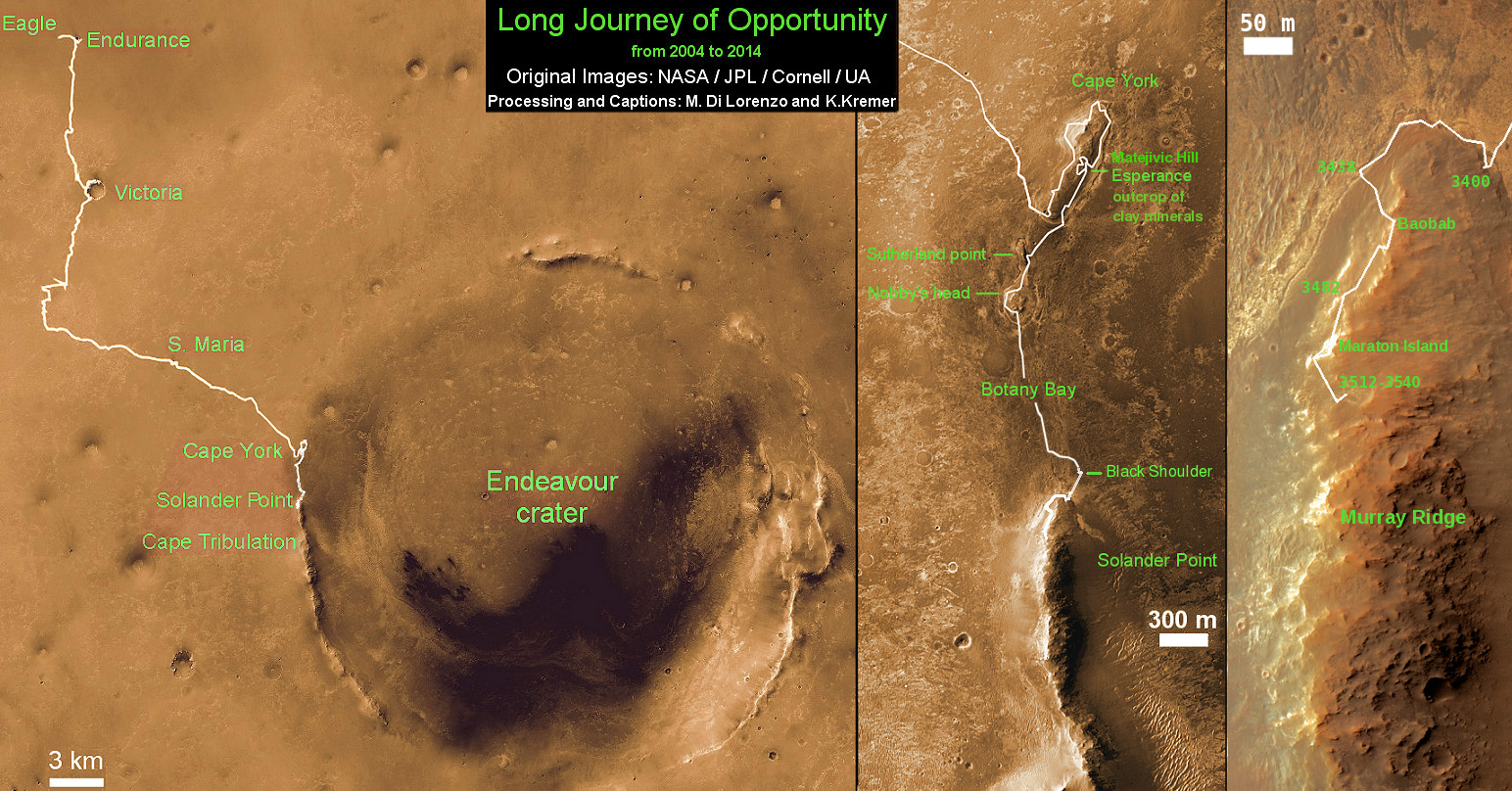
A series of Martian wind events over the past few months has given NASA’s long-lived Opportunity rover a big power boost during its current explorations atop a Red Planet mountain that’s a scientific goldmine.
Altogether, Opportunity has received about a 70-percent boost in power since early January, due to a combination of multiple wind-cleaning events and the advent of spring and more daily hours of sunshine in Mars’ southern hemisphere.
The decade-old robot is exploring “Murray Ridge” on the north-facing slopes of Solander Point mountaintop that is loaded with caches of minerals, including phyllosilicate clay minerals that formed eons ago in flowing liquid neutral water conducive to life.
Murray Ridge and Solander Point lie at the western rim of a vast crater named Endeavour, which spans some 22 kilometers (14 miles) in diameter.
Last week, between Sols 3605 and 3606 (March 15 and March 16, 2014), the solar-powered robot experienced a 10-percent boost in electrical output from the arrays.
This comes on top of another wind-cleaning, 10-percent power boost the prior week.
This week, the solar array output shot up further and currently stands at 615 watt hours, compared to only 371 watt hours on Jan. 1, 2014 (Sol 3534).
More power means the rover can work for longer periods each Sol and conduct more science research.
Opportunity also captured a magnificent “selfie” with her hazcam camera on Sol 3609 (March 20, 2014).

The fisheye camera was looking eastward shortly before sunset and captured the rover’s shadow falling across a slope called the McClure-Beverlin Escarpment atop Solander Point on the western rim of Endeavour Crater.
Opportunity is extending her robotic arm in the general area dubbed “Cook Haven” to image rocks with the arms Microscopic Imager (MI) capture spectra with the Alpha Particle X-ray Spectrometer (APXS).
The terrain atop the summit of Solander Point sometimes makes for difficult driving from spot to spot due to some tilted slopes and slippery sands.

Several drives were interrupted when the rover sensed higher current in three of the six wheels.
Today, March 30, marks Opportunity’s 3619th Sol or Martian Day roving Mars. So far she has snapped over 190,200 amazing images.
She was expected to last a mere three months, with a “warranty” of 90 Martian days (Sols).
Together with her twin sister Spirit, the golf cart-sized robots proved that early Mars was warm and wet, billions of years ago—a key finding in the search for habitats conducive to life beyond Earth.
Her total odometry stands at over 24.10 miles (38.79 kilometers) since touchdown on Jan. 24, 2004, at Meridiani Planum.
Meanwhile, her younger sister Curiosity is trundling across the floor of Gale Crater rover toward towering Mount Sharp. Watch for my upcoming story.
So, Opportunity has managed to survive and thrive through her sixth utterly harsh Martian winter with flying colors, all the while continuing breakthrough science non-stop. What’s not clear is whether she’ll survive the utterly harsh fiscal environment in Washington, D.C.
Continuing cuts to NASA’s budget threaten Opportunity’s very survival even more so than the daily frigid arctic temperatures. Indeed funding may be cut off at the end of the current fiscal year.
Learn more at Ken’s upcoming presentations at the NEAF astro/space convention, N.Y., on April 12/13 and at Washington Crossing State Park, N.J., on April 6.





Maybe the next rover could include a feather duster or at least a blower of some kind?
It is absolutely unbelievable that the Administration is actually even considering de-activating this invaluable source of planetary science. Such an inane, insane, brain-dead suggestion could only be the product of some bizarro-world psychotic chess gambit in the 2015 budget chess game. Right, let’s pull the plug on the Opportunity rover and use the money saved to send surface-to-air weapons to the rebels in Syria who “promise” they won’t hand them over to the Al-Quida fighters who are their dear allies to use against Americans. No doubt our only loyal ally Israel would love for us to hand such El Al airliner-dropping technology over to Syrian rebels. Yeah, turn off Opportunity so we can all climb aboard the crazy train.
Imagine – a “decade-old” Martian rover still performing an amazing scientific mission. And the government wants to cut funding? Rediculous, short-sighted pin-headed thinking.
Correction: “ridiculous”
Tom, the essence of what you said was, as is always the case with you excellent posts, clearly understood and most certainly in no need of correction. I stand with you in complete agreement. When I’m writing while upset over something as serious as the possible loss of the Opportunity rover, my speling is usally the furst thing that sufers. 🙂
I think it is an excellent idea as then the MARS ONE group could just lease it from the government to scout locations and liquid water(we all know its there) for their start up Colony…Or some other group to look for Alien artifacts …what an entertainment show that would be! Those damn engineers at JPL…They just made the Rover to good, to strong and to robust…hahahah